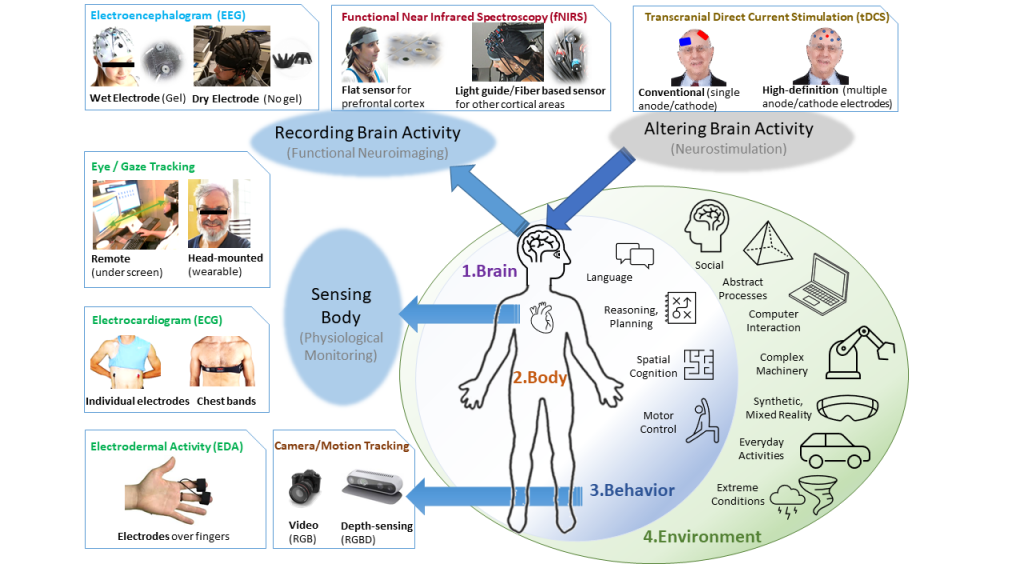We are focused on neuroergonomics for brain health and performance research. We develop and/or utilize diverse wearable neurotechnologies (mobile neuroimaging + multi-modal approaches and neurostimulation), physiological sensing, and behavioral methods to investigate human brain function in realistic and real-world environments, across the lifespan and from healthy (typical to specialized groups) to diverse clinical conditions (mental health to neurological).
We develop methods for mobile neuroimaging and investigate diverse applications. For methods, we develop hardware, software, signal processing algorithms, data analysis, and machine learning. For applications we investigate the use of cutting-edge methods in diverse clinical and field groups in collaboration with leading clinicians and domain experts. We have multiple ongoing studies in neurological and mental health that includes Autism, Down Syndrome, Concussion, Eating disorders, and Addiction. For field applications, understanding human operator during complex machine use, cognitive workload, training/acquisition of new skills (Aviation to Medical training), human-computer/machine interaction as well as human to human communication, social interaction, hyperscanning, and teamwork represent the general scope of research interest.
What is Neuroergonomics?
The understanding of the brain functioning and its utilization for real world applications is the next frontier. Existing studies with traditional neuroimaging approaches have accumulated overwhelming knowledge but are limited in scope, i.e. only in artificial lab settings and with simplified parametric tasks. As an interdisciplinary new field, neuroergonomics aims to fill this gap: Understanding the brain in the wild, its activity during unrestricted real-world tasks in everyday life contexts, and its relationship to action, behavior, body, and environment.
Neuroergonomics is an emerging new interdisciplinary field that aims to investigate the human brain function and its relation to everyday behavior in real-world contexts (1, 2). Neuroergonomics originated towards the end of the last century from the use of scientific thinking in the design of tools, technology and of working environments and builds on the research innovation and applications of human performance, cognitive engineering and cognitive neuroscience(3, 4). Neuroergonomics has been fueled by the recent exponential growth of wearable and mobile neurotechnologies, as well as the know-how and methodological approaches from relevant fields such as neuroscience, neuroengineering, psychology, ergonomics, and human factors(5).


References
1. H. Ayaz, and F. Dehais, Neuroergonomics: The Brain at Work and Everyday Life, 1st ed., Elsevier Academic Press (2019).
2. R. Parasuraman, “Neuroergonomics Brain, Cognition, and Performance at Work,” Current directions in psychological science 20(3), 181-186 (2011).
3. M. I. Posner, “Expanding horizons in ergonomics research,” Neuroimage 59(1), 149-153 (2012).
4. H. Ayaz, and F. Dehais, “Neuroergonomics,” in Handbook of Human Factors and Ergonomics G. Salvendy, and W. Karwowski, Eds., pp. 816-841, Wiley (2021).
5. F. Dehais, W. Karwowski, and H. Ayaz, “Brain at Work and in Everyday Life as the Next Frontier: Grand Field Challenges for Neuroergonomics,” Frontiers in Neuroergonomics 1(1), (2020).
6. A. Curtin, and H. Ayaz, “The Age of Neuroergonomics: Towards Ubiquitous and Continuous Measurement of Brain Function with fNIRS,” Japanese Psychological Research 60(374-386 (2018).
Representative Studies
10. Y. Liu et al., “Measuring speaker–listener neural coupling with functional near infrared spectroscopy,” Scientific reports 7(43293 (2017).
12. C. Barreto et al., “A New Statistical Approach for fNIRS Hyperscanning to Predict Brain Activity of Preschoolers’ Using Teacher’s,” Frontiers in Human Neuroscience 15(181), (2021).
13. T. Gateau, H. Ayaz, and F. Dehais, “In silico vs. Over the Clouds: On-the-Fly Mental State Estimation of Aircraft Pilots, Using a Functional Near Infrared Spectroscopy Based Passive-BCI,” Frontiers in Human Neuroscience 12(187), (2018).
14. R. Mckendrick et al., “Into The Wild: Neuroergonomic Differentiation of Hand-Held and Augmented Reality Wearable Displays During Outdoor Navigation with Functional Near Infrared Spectroscopy,” Frontiers in Human Neuroscience 10((2016).
16. K. S. Gaudry et al., “Projections and the Potential Societal Impact of the Future of Neurotechnologies,” Frontiers in Neuroscience 15(1417), (2021).
17. H. Ayaz et al., “Early diagnosis of traumatic intracranial hematomas,” Journal of Biomedical Optics 24(10 (2019).